
Investor Presentation Cactus, Inc. (NYSE: WHD) September 2020
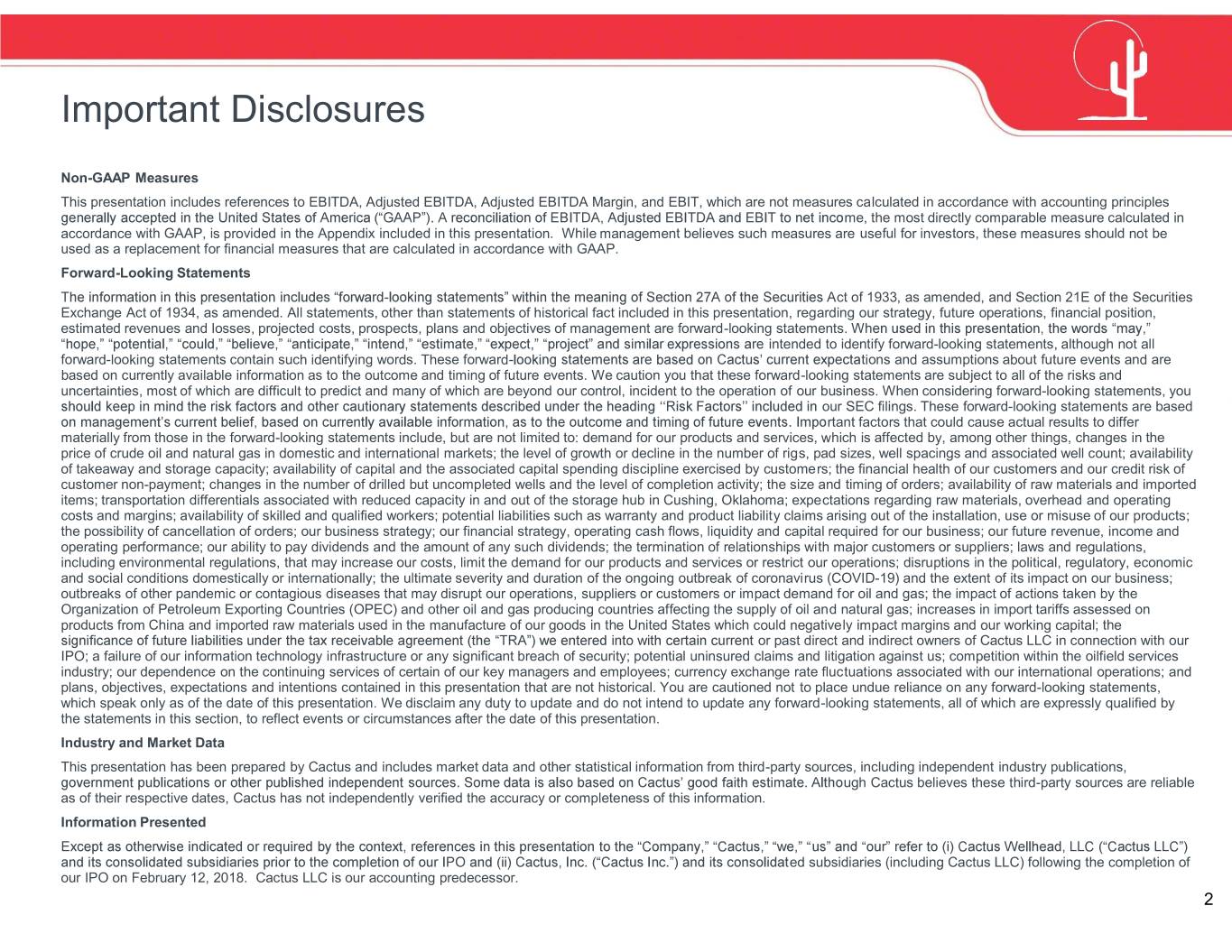
Important Disclosures Non-GAAP Measures This presentation includes references to EBITDA, Adjusted EBITDA, Adjusted EBITDA Margin, and EBIT, which are not measures calculated in accordance with accounting principles me, the most directly comparable measure calculated in accordance with GAAP, is provided in the Appendix included in this presentation. While management believes such measures are useful for investors, these measures should not be used as a replacement for financial measures that are calculated in accordance with GAAP. Forward-Looking Statements - ct of 1933, as amended, and Section 21E of the Securities Exchange Act of 1934, as amended. All statements, other than statements of historical fact included in this presentation, regarding our strategy, future operations, financial position, estimated revenues and losses, projected costs, prospects, plans and objectives of management are forward-looking statements. Wh intended to identify forward-looking statements, although not all forward-looking statements contain such identifying words. These forward- tions and assumptions about future events and are based on currently available information as to the outcome and timing of future events. We caution you that these forward-looking statements are subject to all of the risks and uncertainties, most of which are difficult to predict and many of which are beyond our control, incident to the operation of our business. When considering forward-looking statements, you our SEC filings. These forward-looking statements are based rtant factors that could cause actual results to differ materially from those in the forward-looking statements include, but are not limited to: demand for our products and services, which is affected by, among other things, changes in the price of crude oil and natural gas in domestic and international markets; the level of growth or decline in the number of rigs, pad sizes, well spacings and associated well count; availability of takeaway and storage capacity; availability of capital and the associated capital spending discipline exercised by customers; the financial health of our customers and our credit risk of customer non-payment; changes in the number of drilled but uncompleted wells and the level of completion activity; the size and timing of orders; availability of raw materials and imported items; transportation differentials associated with reduced capacity in and out of the storage hub in Cushing, Oklahoma; expectations regarding raw materials, overhead and operating costs and margins; availability of skilled and qualified workers; potential liabilities such as warranty and product liability claims arising out of the installation, use or misuse of our products; the possibility of cancellation of orders; our business strategy; our financial strategy, operating cash flows, liquidity and capital required for our business; our future revenue, income and operating performance; our ability to pay dividends and the amount of any such dividends; the termination of relationships with major customers or suppliers; laws and regulations, including environmental regulations, that may increase our costs, limit the demand for our products and services or restrict our operations; disruptions in the political, regulatory, economic and social conditions domestically or internationally; the ultimate severity and duration of the ongoing outbreak of coronavirus (COVID-19) and the extent of its impact on our business; outbreaks of other pandemic or contagious diseases that may disrupt our operations, suppliers or customers or impact demand for oil and gas; the impact of actions taken by the Organization of Petroleum Exporting Countries (OPEC) and other oil and gas producing countries affecting the supply of oil and natural gas; increases in import tariffs assessed on products from China and imported raw materials used in the manufacture of our goods in the United States which could negatively impact margins and our working capital; the or past direct and indirect owners of Cactus LLC in connection with our IPO; a failure of our information technology infrastructure or any significant breach of security; potential uninsured claims and litigation against us; competition within the oilfield services industry; our dependence on the continuing services of certain of our key managers and employees; currency exchange rate fluctuations associated with our international operations; and plans, objectives, expectations and intentions contained in this presentation that are not historical. You are cautioned not to place undue reliance on any forward-looking statements, which speak only as of the date of this presentation. We disclaim any duty to update and do not intend to update any forward-looking statements, all of which are expressly qualified by the statements in this section, to reflect events or circumstances after the date of this presentation. Industry and Market Data This presentation has been prepared by Cactus and includes market data and other statistical information from third-party sources, including independent industry publications, ugh Cactus believes these third-party sources are reliable as of their respective dates, Cactus has not independently verified the accuracy or completeness of this information. Information Presented i ed subsidiaries (including Cactus LLC) following the completion of our IPO on February 12, 2018. Cactus LLC is our accounting predecessor. 2

Executive Team Mr. Bender has served as President and CEO since co- Mr. Bender previously was President of Wood Group Pressure Control from 2000 to 2011. Scott Bender Mr. Bender successfully built and monetized Ingram Cactus Company (sold to Cameron in 1996) and led Wood Group President & CEO Mr. Bender graduated from Princeton University in 1975 with a Bachelor of Science in Engineering and from the University of Texas at Austin in 1977 with a Master of Business Administration. Mr. Bender has served as Senior Vice President and COO since co-founding Cactus LLC in 2011. Joel Bender Mr. Bender previously was Senior Vice President of Wood Group Pressure Control from 2000 to 2011. Mr. Bender successfully built and monetized Ingram Cactus Company (sold to Cameron in 1996) and led Wood Group Senior Vice President & Chief Operating Officer Mr. Bender graduated from Washington University in 1981 with a Bachelor of Science in Engineering and from the University of Houston in 1985 with a Master of Business Administration. Mr. Bender has served as Vice President of Operations of Cactus LLC since 2011, managing all US service center and field operations. Steven Bender Vice President of Mr. Bender previously was Rental Business Manager of Wood Group Pressure Control from 2005 to 2011. Operations Mr. Bender graduated from Rice University in 2005 with a Bachelor of Arts in English and Hispanic Studies and from the University of Texas at Austin in 2010 with a Master of Business Administration. Mr. Tadlock has served as Vice President, Chief Financial Officer & Treasurer, since March 2019. Steve Tadlock Mr. Tadlock previously served as Vice President and Chief Administrative Officer since March 2018 and has also served as VP of Corporate Services since June 2017. He has worked with Cactus LLC since its founding in 2011 as a Board Vice President, Chief observer. Financial Officer & Mr. Tadlock previously worked at Cadent Energy Partners, where he served as a Partner from 2014 to 2017. Treasurer Mr. Tadlock graduated from Princeton University in 2001 with a Bachelor of Science in Engineering and from the Wharton School at the University of Pennsylvania in 2007 with a Master of Business Administration. Mr. Isaac has served as Vice President of Administration and General Counsel since September 2018. David Isaac Mr. Isaac previously worked at Rockwater Energy Solutions, Inc. and most recently served as Senior Vice President of Vice President of Human Resources and General Counsel. Administration and Mr. Isaac previously was the Vice President of Human Resources and General Counsel of Inmar, Inc. General Counsel Mr. Isaac graduated from The College of William & Mary in 1983 with a Bachelor of Arts in Economics and from The Ohio State University in 1986 with a Juris Doctor. 3
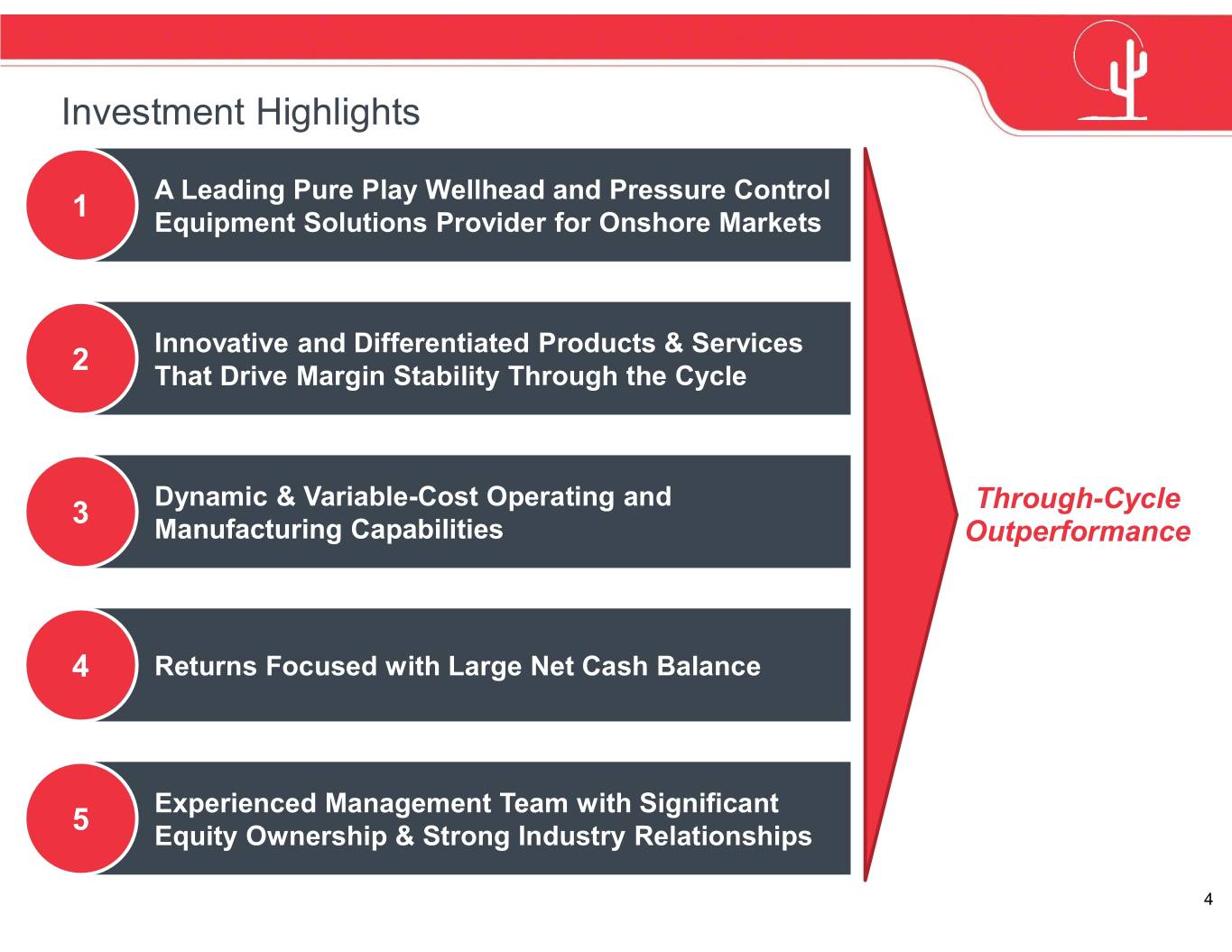
Investment Highlights A Leading Pure Play Wellhead and Pressure Control 1 Equipment Solutions Provider for Onshore Markets Innovative and Differentiated Products & Services 2 That Drive Margin Stability Through the Cycle Dynamic & Variable-Cost Operating and 3 Through-Cycle Manufacturing Capabilities Outperformance 4 Returns Focused with Large Net Cash Balance Experienced Management Team with Significant 5 Equity Ownership & Strong Industry Relationships 4

Company Overview Cactus designs, manufactures, sells and rents highly engineered products which yield greater pad drilling and completions efficiencies while enhancing safety Q2 2020 LTM Revenue by Type Revenue ($ in millions) $628.4 $544.1 $521.7 Field $341.2 Service and $155.0 Other 21% Rental Product 2016 2017 2018 2019 LTM Q2 2020 21% 58% 33.4% 37.1% AdjustedMargin EBITDAMargin (1) ($ in millions) $212.6 $229.0 $183.9 $112.1 $32.2 *Product Revenue Includes Drilling and Production Consumables 2016 2017 2018 2019 LTM Q2 2020 Selected Active Basins Adj. EBITDA(1) as % of 20.8% 32.9% 39.1% 36.4% 35.2% Bakken DJ / Powder River Revenue Adjusted EBITDA(1) Net Capital Expenditures(2) as % of Revenue Eagle Ford Marcellus / Utica 27.5% Permian SCOOP / STACK 23.9% 26.5% 26.9% Cooper, Australia 9.6% 2016 2017 2018 2019 LTM Q2 2020 Source: Company filings. 5 1) EBITDA and Adjusted EBITDA are non-GAAP financial measures. The Appendix at the back of this presentation contains a reconciliation of EBITDA and Adjusted EBITDA to net income, the most comparable financial measure calculated in accordance with GAAP. 2) Net Capital Expenditures equals net cash flows from investing activities.

Proprietary Equipment Across Drilling, Completion, and Production Phases of a Well Technologically advanced wellhead and frac solutions deliver greater reliability and time savings Designed for pad drilling and intense completion environments Principal products: SafeDrill® wellheads, frac related rentals and production trees Time savings can exceed 30 hours of rig time per well DrillingCompletion (Frac) Production Consumable Sale Temporary Rental Consumable Sale Cactus Also Provides Field Service, Installation & Maintenance 6

Market Leader with Strong Market Share Growth Historical U.S. Onshore Market Share(1) 400 35.0% 32.7% 30.9% 350 29.3% Cactus Rigs Followed 28.2% 30.0% 27.0% 26.6% (1) Market Share 295 300 24.4% 275 276 25.0% 21.5% 245 250 240 220 20.0% 17.5% 200 179 14.4% 14.5% 158 15.0% 150 129 119 119 100 99 10.0% 100 9.8% 87 75 8.9% 68 47 7.0% 5.0% 50 5.9% 4.3% 15 2.5% 0.8% 0 0.0% Dec-11 Jun-12 Dec-12 Jun-13 Dec-13 Jun-14 Dec-14 Jun-15 Dec-15 Jun-16 Dec-16 Jun-17 Dec-17 Jun-18 Dec-18 Jun-19 Dec-19 Jun-20 U.S. Onshore 1,931 1,899 1,729 1,694 1,703 1,780 1,820 825 684 388 601 902 909 1,035 1,045 941 777 266 Rigs 2015 2016 Downturn Was Source of Significant Market Share Gains Source: Baker Hughes Rig Count Data, as published on the Friday on or immediately preceding the 15th day of each month presented, and Cactus analysis. 1) Represents the number of active U.S. onshore rigs Cactus followed divided by the total number of active U.S. onshore rigs, as of mid-month. The number of active U.S. onshore rigs Cactus followed represents the approximate number of active U.S. onshore drilling rigs to which Cactus was the primary provider of wellhead products and corresponding services during drilling, as of mid-month. Cactus believes that comparing the total number of active U.S. onshore rigs to which it is providing its products and services at a given time to the total number of active U.S. onshore rigs on or about such time provides Cactus with a reasonable approximation of its market share with respect to its wellhead products sold and the corresponding services it provides. 7
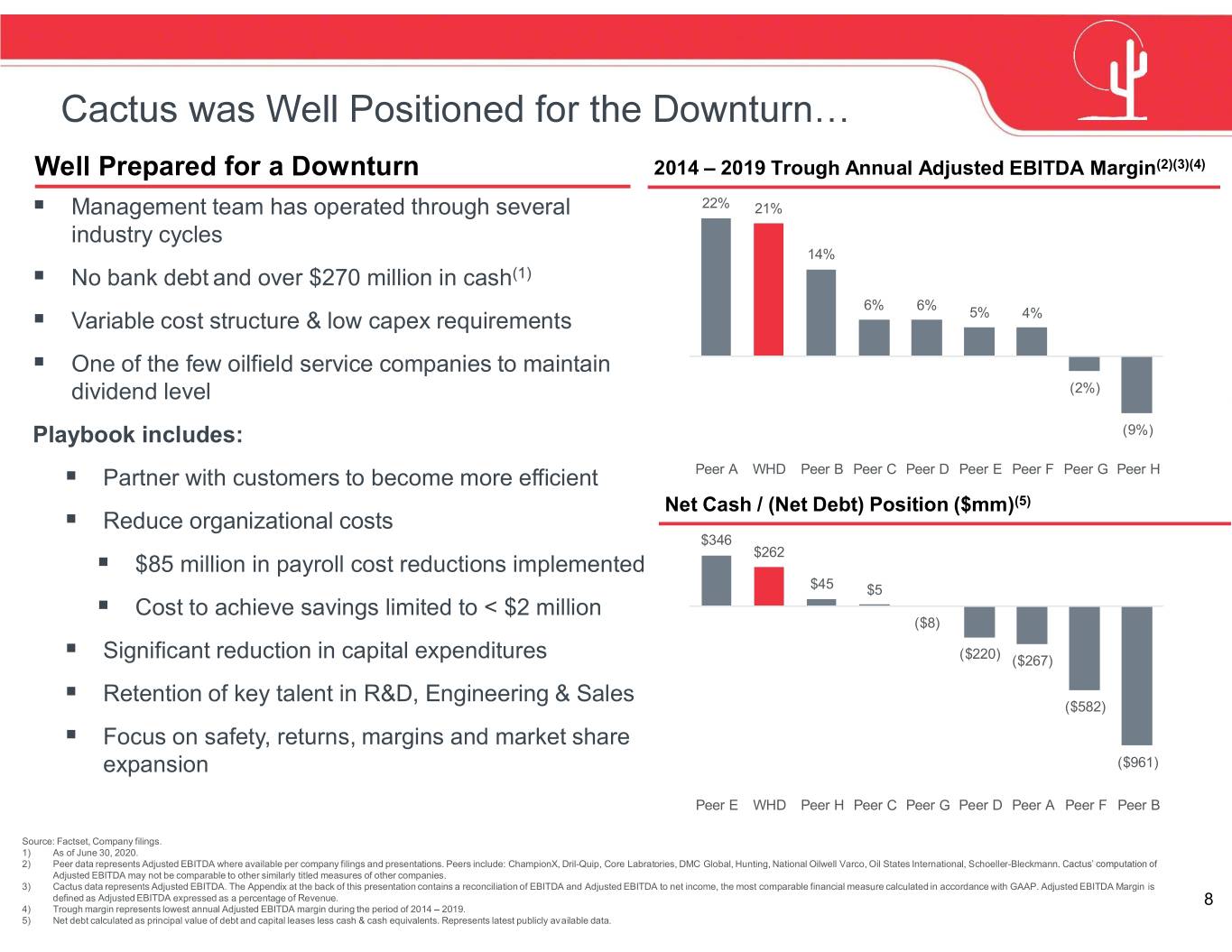
Well Prepared for a Downturn 2014 2019 Trough Annual Adjusted EBITDA Margin(2)(3)(4) Management team has operated through several 22% 21% industry cycles 14% No bank debt and over $270 million in cash(1) 6% 6% Variable cost structure & low capex requirements 5% 4% One of the few oilfield service companies to maintain dividend level (2%) Playbook includes: (9%) Partner with customers to become more efficient Peer A WHD Peer B Peer C Peer D Peer E Peer F Peer G Peer H Net Cash / (Net Debt) Position ($mm)(5) Reduce organizational costs - $346 $262 $85 million in payroll cost reductions implemented $45 $5 Cost to achieve savings limited to < $2 million ($8) Significant reduction in capital expenditures ($220) ($267) Retention of key talent in R&D, Engineering & Sales ($582) Focus on safety, returns, margins and market share expansion ($961) Peer E WHD Peer H Peer C Peer G Peer D Peer A Peer F Peer B Source: Factset, Company filings. 1) As of June 30, 2020. 2) Peer data represents Adjusted EBITDA where available per company filings and presentations. Peers include: ChampionX, Dril-Quip, Core Labratories, DMC Global, Hunting, National Oilwell Varco, Oil States International, Schoeller-Bleckmann Adjusted EBITDA may not be comparable to other similarly titled measures of other companies. 3) Cactus data represents Adjusted EBITDA. The Appendix at the back of this presentation contains a reconciliation of EBITDA and Adjusted EBITDA to net income, the most comparable financial measure calculated in accordance with GAAP. Adjusted EBITDA Margin is defined as Adjusted EBITDA expressed as a percentage of Revenue. 8 4) Trough margin represents lowest annual Adjusted EBITDA margin during the period of 2014 2019. 5) Net debt calculated as principal value of debt and capital leases less cash & cash equivalents. Represents latest publicly available data.
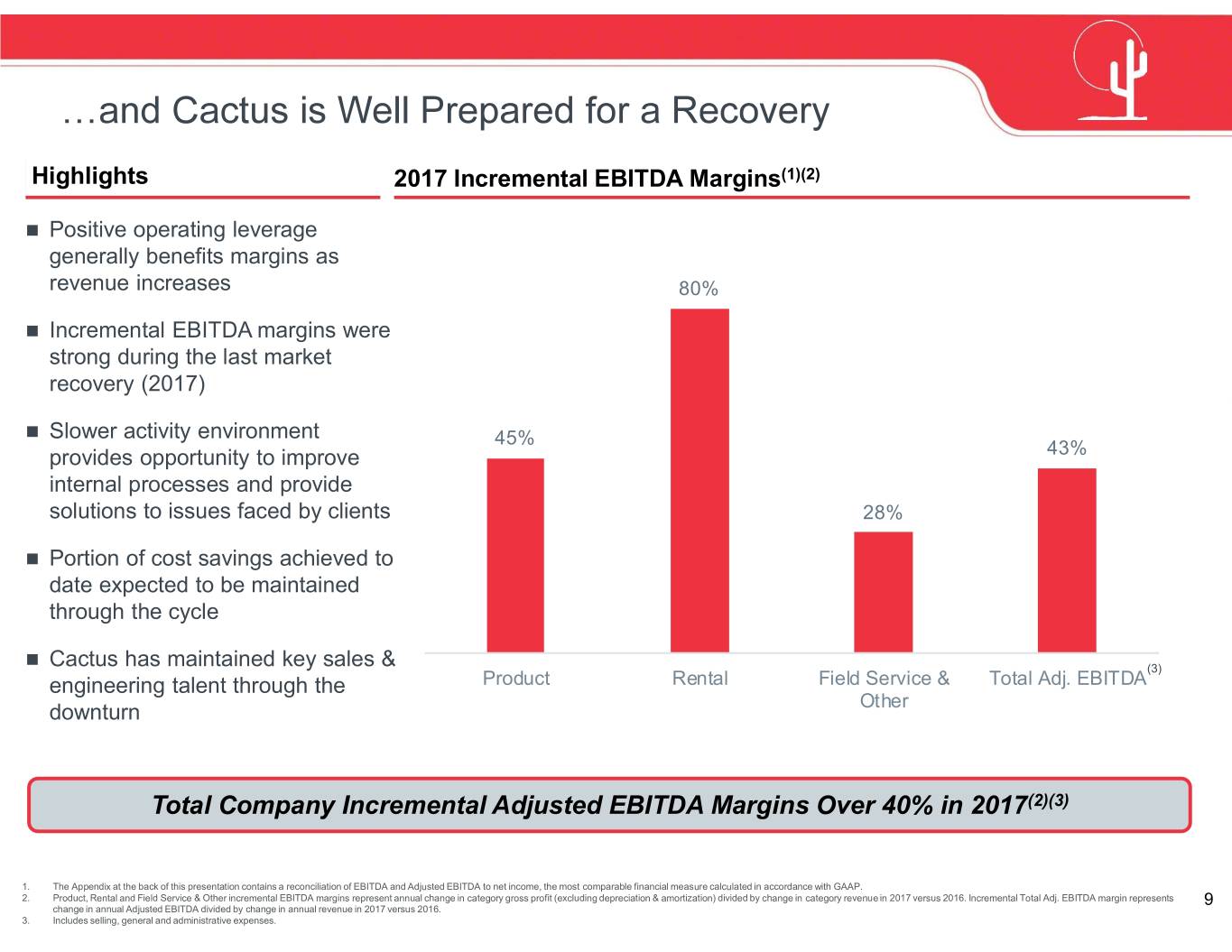
Highlights 2017 Incremental EBITDA Margins(1)(2) Positive operating leverage generally benefits margins as revenue increases 80% Incremental EBITDA margins were strong during the last market recovery (2017) Slower activity environment 45% provides opportunity to improve 43% internal processes and provide solutions to issues faced by clients 28% Portion of cost savings achieved to date expected to be maintained through the cycle Cactus has maintained key sales & (3) engineering talent through the Product Rental Field Service & Total Adj. EBITDA Other downturn Total Company Incremental Adjusted EBITDA Margins Over 40% in 2017(2)(3) 1. The Appendix at the back of this presentation contains a reconciliation of EBITDA and Adjusted EBITDA to net income, the most comparable financial measure calculated in accordance with GAAP. 2. Product, Rental and Field Service & Other incremental EBITDA margins represent annual change in category gross profit (excluding depreciation & amortization) divided by change in category revenue in 2017 versus 2016. Incremental Total Adj. EBITDA margin represents 9 change in annual Adjusted EBITDA divided by change in annual revenue in 2017 versus 2016. 3. Includes selling, general and administrative expenses.
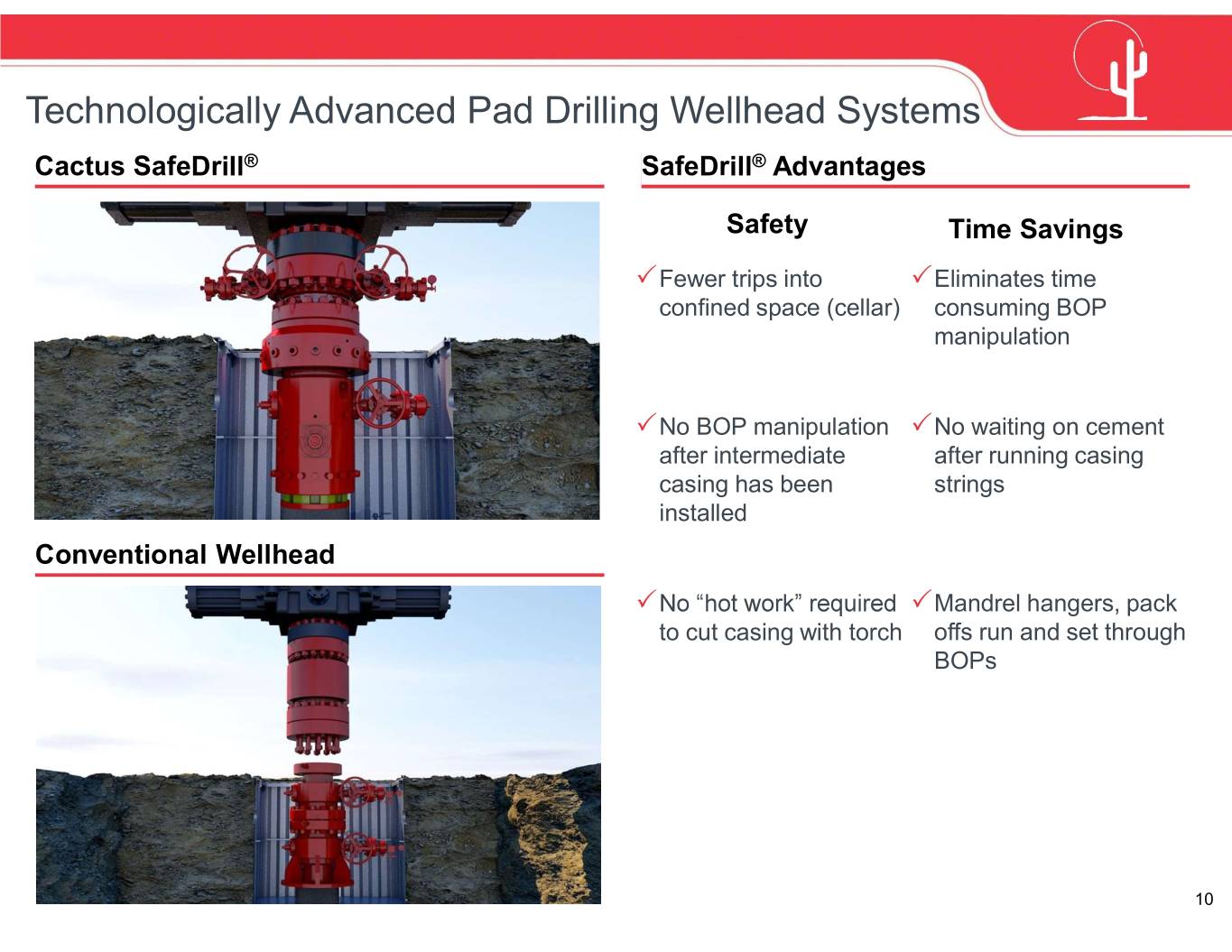
Technologically Advanced Pad Drilling Wellhead Systems Cactus SafeDrill® SafeDrill® Advantages Safety Time Savings Fewer trips into Eliminates time confined space (cellar) consuming BOP - manipulation No BOP manipulation No waiting on cement after intermediate after running casing casing has been strings installed - Conventional Wellhead Mandrel hangers, pack to cut casing with torch offs run and set through BOPs 10
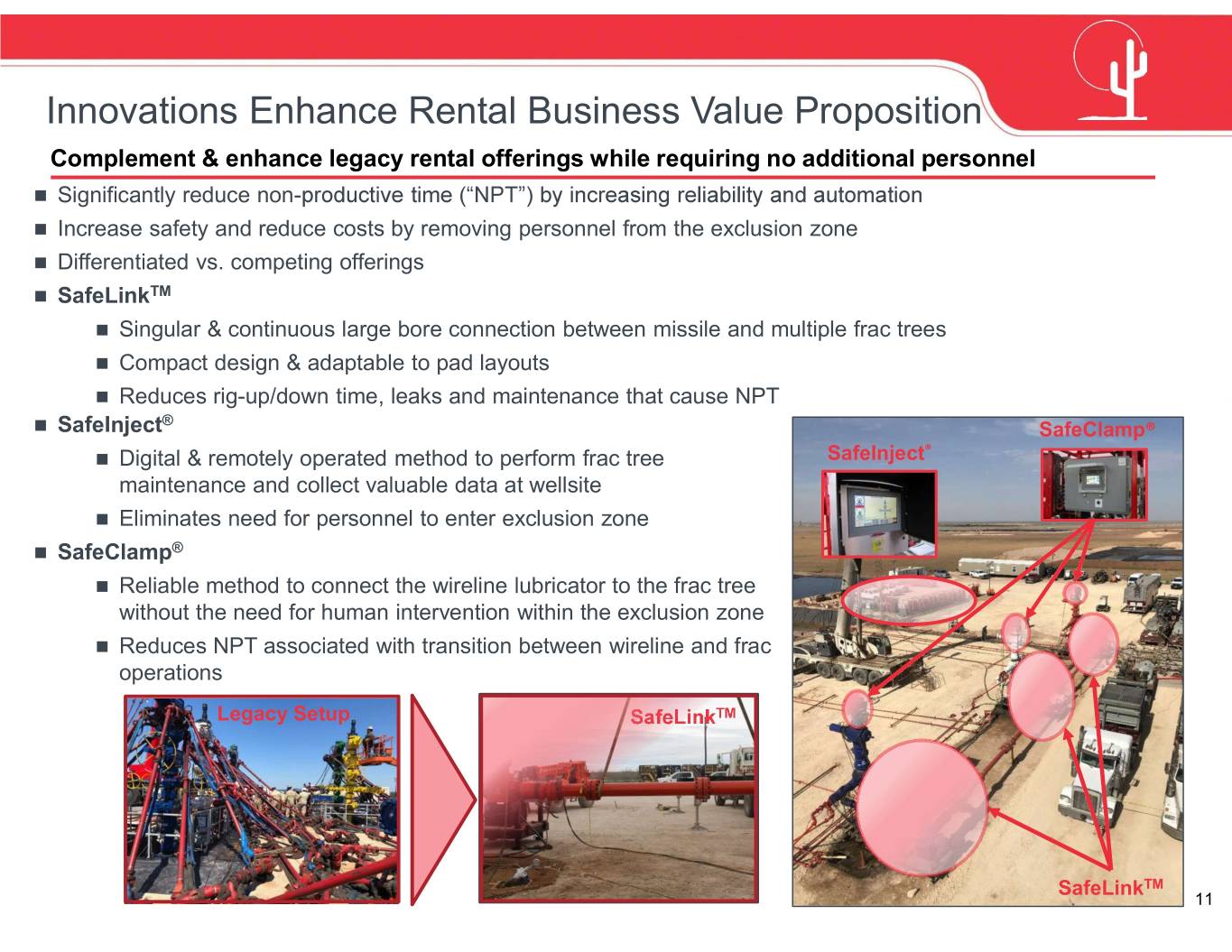
Innovations Enhance Rental Business Value Proposition Complement & enhance legacy rental offerings while requiring no additional personnel Significantly reduce non- Increase safety and reduce costs by removing personnel from the exclusion zone Differentiated vs. competing offerings SafeLinkTM Singular & continuous large bore connection between missile and multiple frac trees Compact design & adaptable to pad layouts Reduces rig-up/down time, leaks and maintenance that cause NPT ® SafeInject SafeClamp® Digital & remotely operated method to perform frac tree SafeInject® maintenance and collect valuable data at wellsite Eliminates need for personnel to enter exclusion zone SafeClamp® Reliable method to connect the wireline lubricator to the frac tree without the need for human intervention within the exclusion zone Reduces NPT associated with transition between wireline and frac operations Legacy Setup SafeLinkTM SafeLinkTM 11
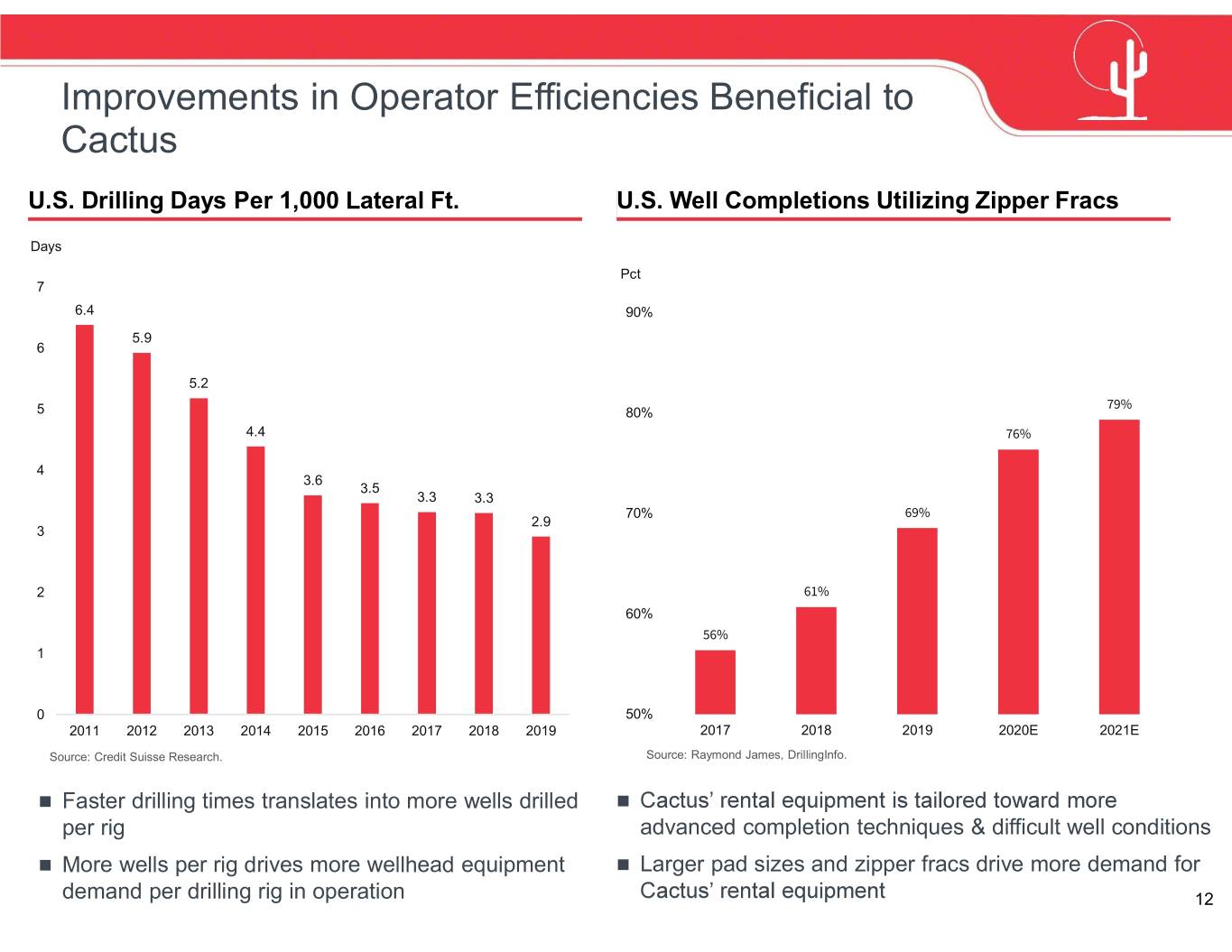
Improvements in Operator Efficiencies Beneficial to Cactus U.S. Drilling Days Per 1,000 Lateral Ft. U.S. Well Completions Utilizing Zipper Fracs Days Pct 7 6.4 90% 5.9 6 5.2 5 80% 4.4 4 3.6 3.5 3.3 3.3 70% 2.9 3 2 60% 1 0 50% 2011 2012 2013 2014 2015 2016 2017 2018 2019 2017 2018 2019 2020E 2021E Source: Credit Suisse Research. Source: Raymond James, DrillingInfo. Faster drilling times translates into more wells drilled per rig advanced completion techniques & difficult well conditions More wells per rig drives more wellhead equipment Larger pad sizes and zipper fracs drive more demand for demand per drilling rig in operation 12
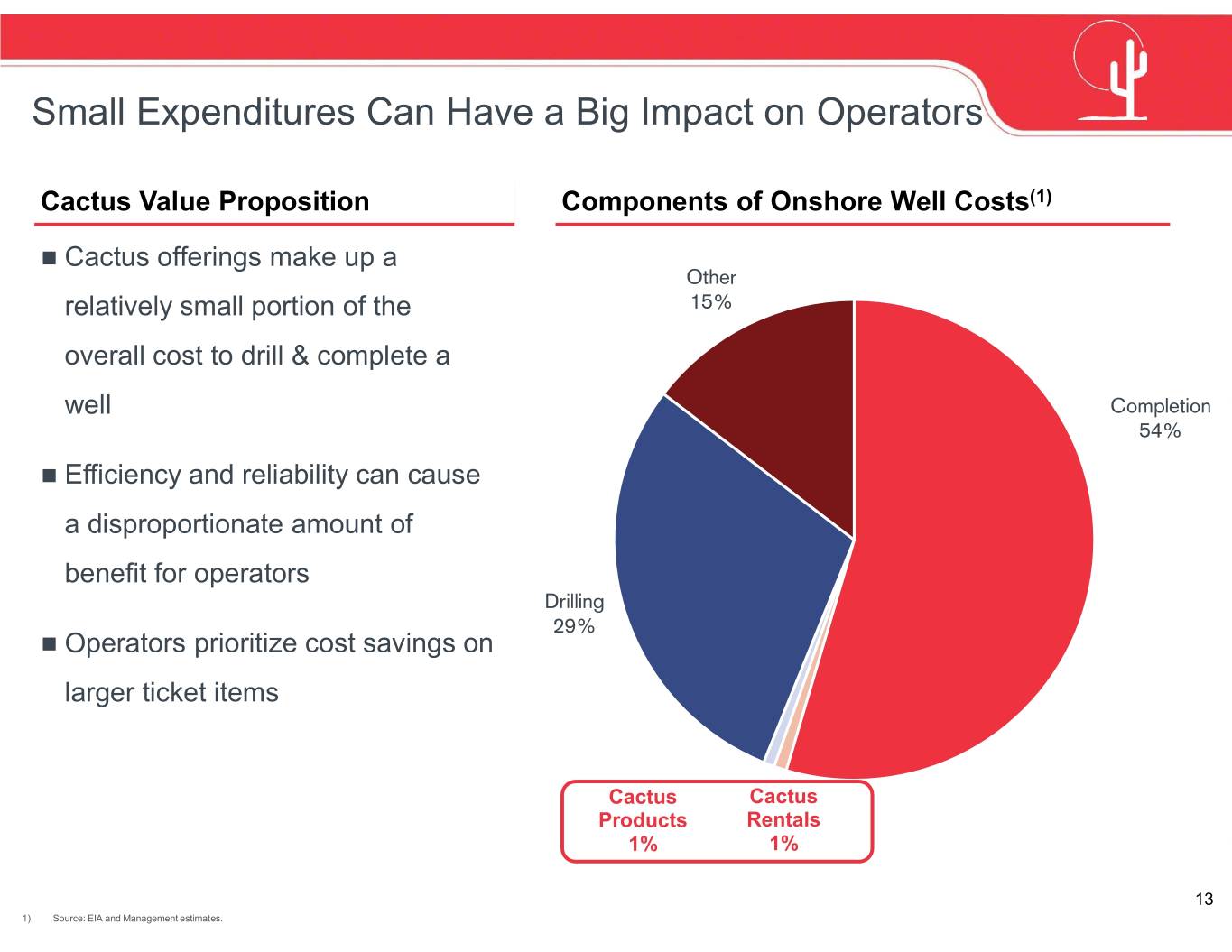
Small Expenditures Can Have a Big Impact on Operators Cactus Value Proposition Components of Onshore Well Costs(1) Cactus offerings make up a Other relatively small portion of the 15% overall cost to drill & complete a well Completion 54% Efficiency and reliability can cause a disproportionate amount of benefit for operators Drilling 29% Operators prioritize cost savings on larger ticket items Cactus Cactus Products Rentals 1% 1% 13 1) Source: EIA and Management estimates.

Flexible and Scalable Operating Footprint U.S. Operations Service centers support field services and provide repair United States services Bakken Bossier City, Louisiana Powder Manufacturing Facility Well-diversified across all key producing basins River Basin Marcellus Utica Flexible cost structure at branches & Bossier City DJ / Niobrara SCOOP / STACK Leased facility arrangements reduce capital needs Delaware Barnett Midland Haynesville Ability to scale costs and right-size in real-time Gulf Coast Eagle Ford Minimal maintenance capex required for up-keep Manufacturing Service Centers Headquarters Oil & Gas Basin International Operations Forming key partnerships and expanding services in the Australia China Middle East Suzhou, China Manufacturing Facility Modest capital requirement for facilities Australian operations predominantly natural gas focused Middle East Low fixed cost for Chinese manufacturing base limits impact from changes in activity levels 14
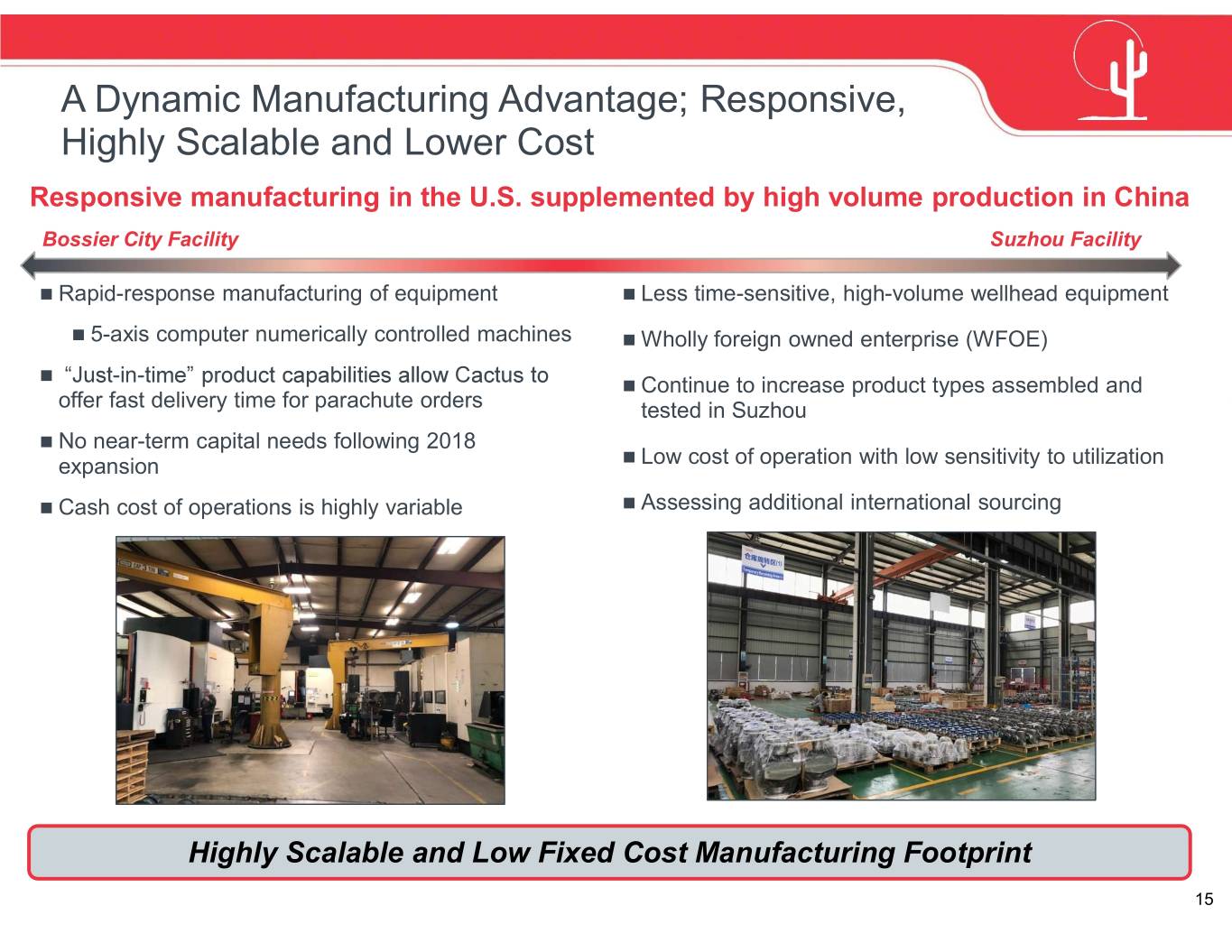
A Dynamic Manufacturing Advantage; Responsive, Highly Scalable and Lower Cost Responsive manufacturing in the U.S. supplemented by high volume production in China Bossier City Facility Suzhou Facility Rapid-response manufacturing of equipment Less time-sensitive, high-volume wellhead equipment 5-axis computer numerically controlled machines Wholly foreign owned enterprise (WFOE) -in- Continue to increase product types assembled and offer fast delivery time for parachute orders tested in Suzhou No near-term capital needs following 2018 expansion Low cost of operation with low sensitivity to utilization Cash cost of operations is highly variable Assessing additional international sourcing Highly Scalable and Low Fixed Cost Manufacturing Footprint 15

Experienced and Well Aligned Management Team with Strong Industry Relationships Management team is well incentivized as it owns more than 25% of the business 2020 executive management salaries reduced by 33 - 55% Performance-based stock compensation Management team has built the foundation of this company over four decades Track record of building and successfully monetizing similar businesses Current Strength of leadership is attested by management and operating teams that joined from past ventures 1959 19751980 1985 1990 1995 2000 2005 2010 2015 ICC sold to Joel Bender Cooper Cameron Scott Bender appointed Vice Cactus, Inc. Corporation leaves WGPC President of IPO (2018) (1996) (2010) CWE (1984) Scott Bender appointed President of CWE Merges with Ingram WGPC Cactus Cactus Petroleum Services, forming Scott and Joel Scott and Steven Bender Sold to GE Cactus, Inc. Pipe Wellhead Ingram Cactus Bender appointed Joel Bender appointed Oil and initiates founded Equipment President and SVP, found Rental regular (1959) respectively, of Gas (2011) Scott and Joel Bender Business Cactus LLC quarterly subsidiary of Wood Group become President Manager of with 18 key dividend Cactus Pipe Pressure Control and VP Operations, WGPC (2005) managers (2019) (1977) respectively, of (2011) ICC (1986) 16

Well Established Relationships with High-Quality Customer Base 1H20 Total Revenue by Customer Type 1H20 Product Revenue by Customer Type 1H20 Rental Revenue by Customer Type Other MajorsMajors Other Majors Other 1% 8%9% 1% 2% Private 0% Private Private 14% Majors 20% 22% 23% SMID E&P 9% SMID E&P SMID10% SMID E&P E&P 16% 11% Large LargeE&P Large Large E&P54% E&P E&P 61% 64% 54% Majority of customer base represented by larger, well capitalized operators 17 Note: Large E&P represents exploration & production companies with market capitalization of over $1bn as of September 1, 2020 per FactSet. Majors include international oil companies that engage in upstream and downstream activities
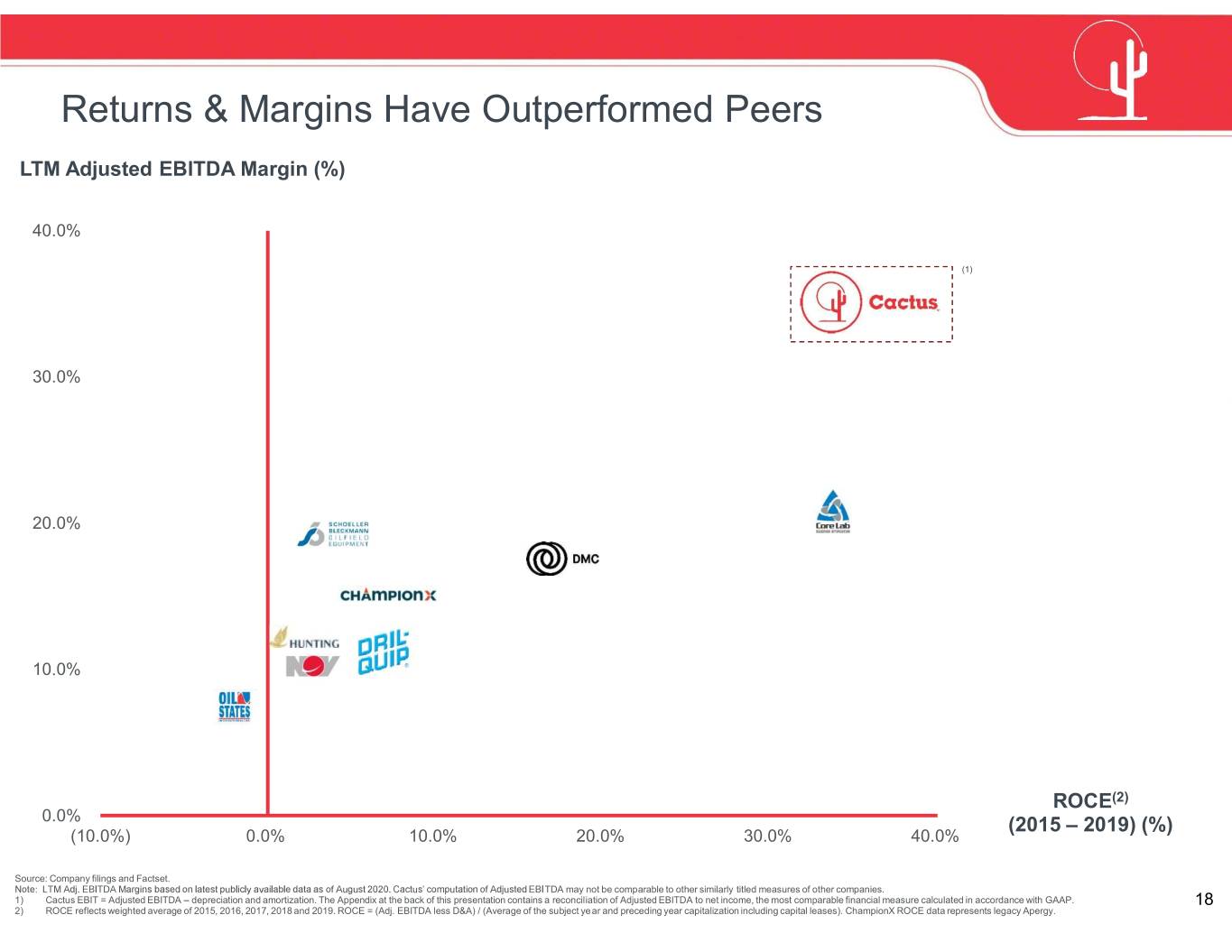
Returns & Margins Have Outperformed Peers LTM Adjusted EBITDA Margin (%) 40.0% (1) 30.0% NCSM SBO 20.0% FTI OIS WEIR NOV FET HTG 10.0% ROCE(2) 0.0% DRQ (2015 2019) (%) (10.0%) 0.0% 10.0% 20.0% 30.0% 40.0% Source: Company filings and Factset. TDA may not be comparable to other similarly titled measures of other companies. 1) Cactus EBIT = Adjusted EBITDA depreciation and amortization. The Appendix at the back of this presentation contains a reconciliation of Adjusted EBITDA to net income, the most comparable financial measure calculated in accordance with GAAP. 18 2) ROCE reflects weighted average of 2015, 2016, 2017, 2018 and 2019. ROCE = (Adj. EBITDA less D&A) / (Average of the subject year and preceding year capitalization including capital leases). ChampionX ROCE data represents legacy Apergy.
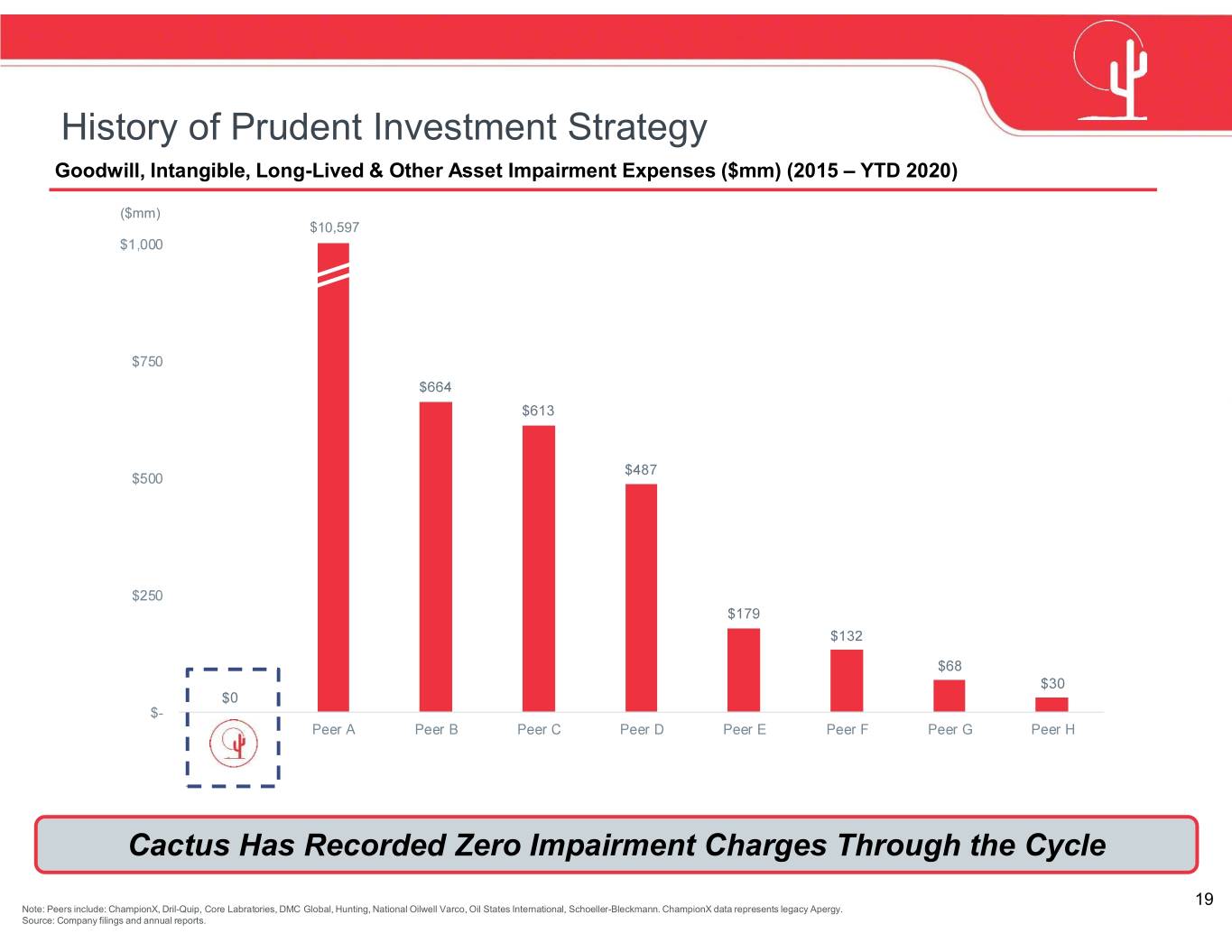
History of Prudent Investment Strategy Goodwill, Intangible, Long-Lived & Other Asset Impairment Expenses ($mm) (2015 YTD 2020) ($mm) $10,597 Cactus Has Recorded Zero Impairment Charges Through the Cycle 19 Note: Peers include: ChampionX, Dril-Quip, Core Labratories, DMC Global, Hunting, National Oilwell Varco, Oil States International, Schoeller-Bleckmann. ChampionX data represents legacy Apergy. Source: Company filings and annual reports.
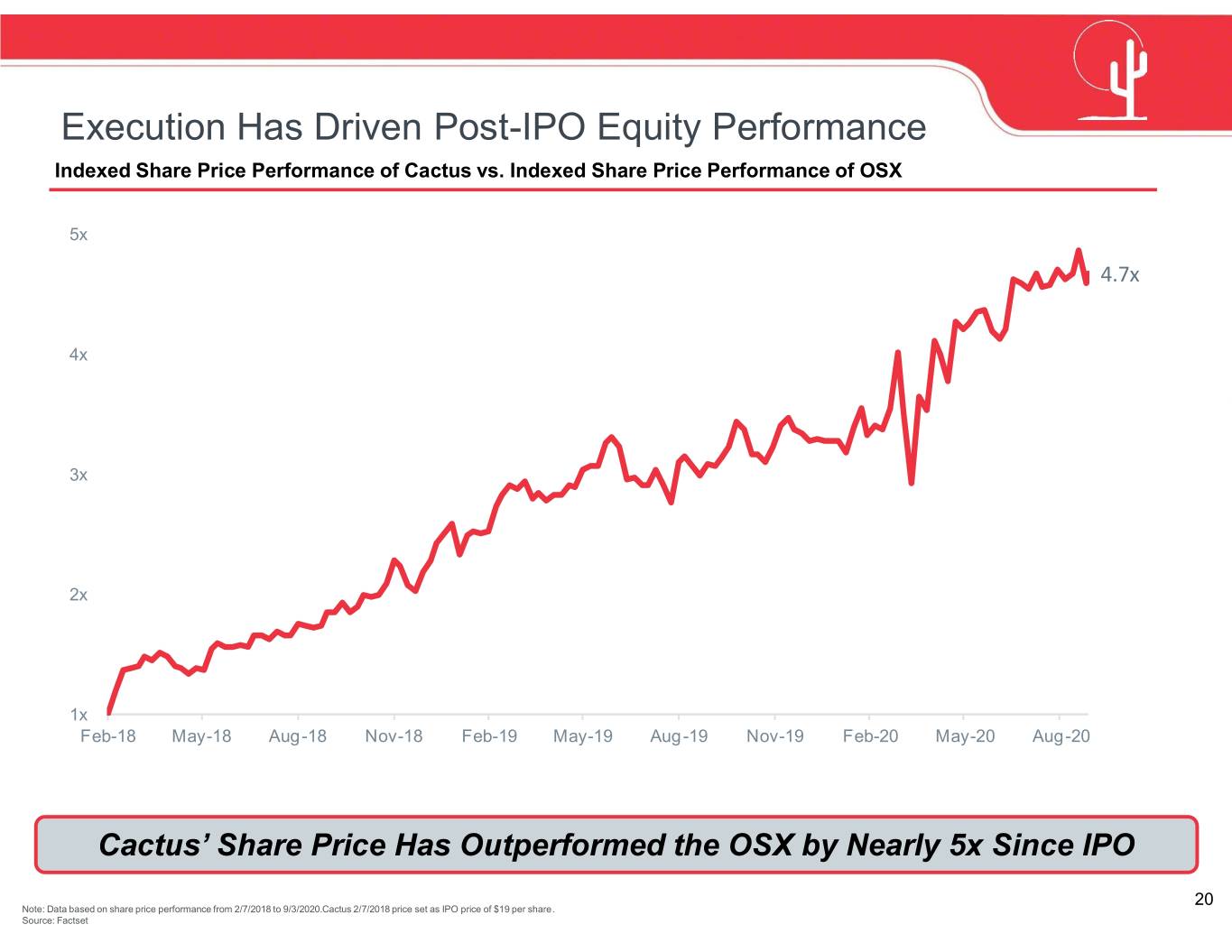
Execution Has Driven Post-IPO Equity Performance Indexed Share Price Performance of Cactus vs. Indexed Share Price Performance of OSX 5x 4.7x 4x 3x 2x 1x Feb-18 May-18 Aug-18 Nov-18 Feb-19 May-19 Aug-19 Nov-19 Feb-20 May-20 Aug-20 20 Note: Data based on share price performance from 2/7/2018 to 9/3/2020.Cactus 2/7/2018 price set as IPO price of $19 per share. Source: Factset

Clean Balance Sheet & Low Capital Intensity Adjusted EBITDA(1) Net Capital Expenditures(2) ($ in Balance Sheet & Capital Summary millions) June 30, 2020 cash balance of $270.7 million $173.1 Expect 2020 to be a year of meaningful cash $144.4 $140.1 generation Ability to quickly scale back growth capital $81.4 expenditures Modest maintenance capex requirements $14.8 Full year 2020 net capital expenditure guidance of $20 to $25 million 2016 2017 2018 2019 LTM Q2 2020 Net Capital Expenditures(2) ($ in millions) Majority of capital expenditures committed to before March of 2020 $68.2 Anticipate annualized run-rate of $55.9 approximately $10 million by year-end $43.7 $30.7 $17.4 2016 2017 2018 2019 LTM Q2 2020 Strong balance sheet with track record of cash flow generation Source: Company filings. 1) EBITDA and Adjusted EBITDA are non-GAAP financial measures. Cactus defines Adjusted EBITDA as EBITDA excluding (gain) loss on debt extinguishment, stock-based compensation, non-cash adjustments for the revaluation of the liability related to the tax receivable 21 agreement, and equity offering expenses. The Appendix at the back of this presentation contains a reconciliation of EBITDA and Adjusted EBITDA to net income, the most comparable financial measure calculated in accordance with GAAP. 2) Net Capital Expenditures equals net cash flows from investing activities.
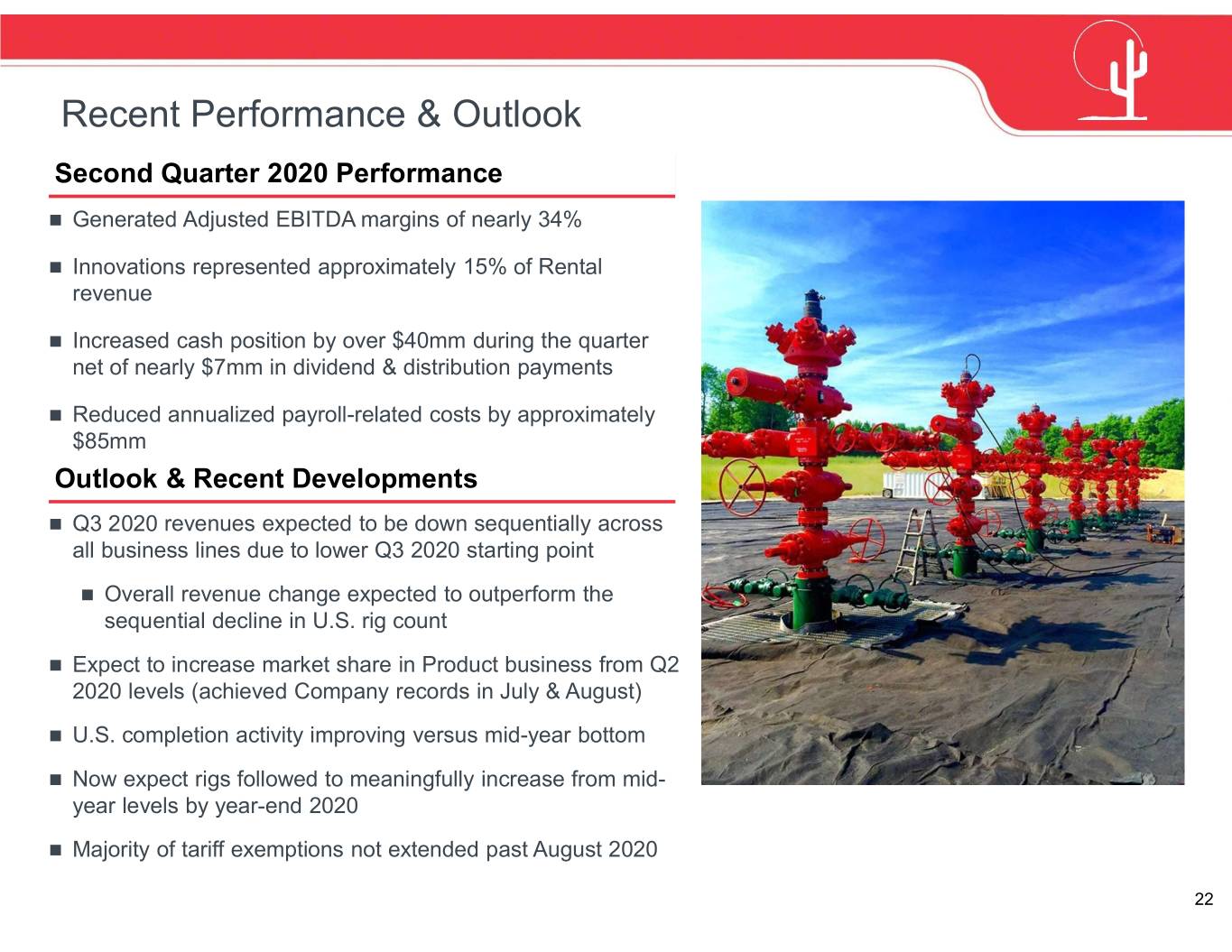
Recent Performance & Outlook Second Quarter 2020 Performance Generated Adjusted EBITDA margins of nearly 34% Innovations represented approximately 15% of Rental revenue Increased cash position by over $40mm during the quarter net of nearly $7mm in dividend & distribution payments Reduced annualized payroll-related costs by approximately $85mm Outlook & Recent Developments Q3 2020 revenues expected to be down sequentially across all business lines due to lower Q3 2020 starting point Overall revenue change expected to outperform the sequential decline in U.S. rig count Expect to increase market share in Product business from Q2 2020 levels (achieved Company records in July & August) U.S. completion activity improving versus mid-year bottom Now expect rigs followed to meaningfully increase from mid- year levels by year-end 2020 Majority of tariff exemptions not extended past August 2020 22
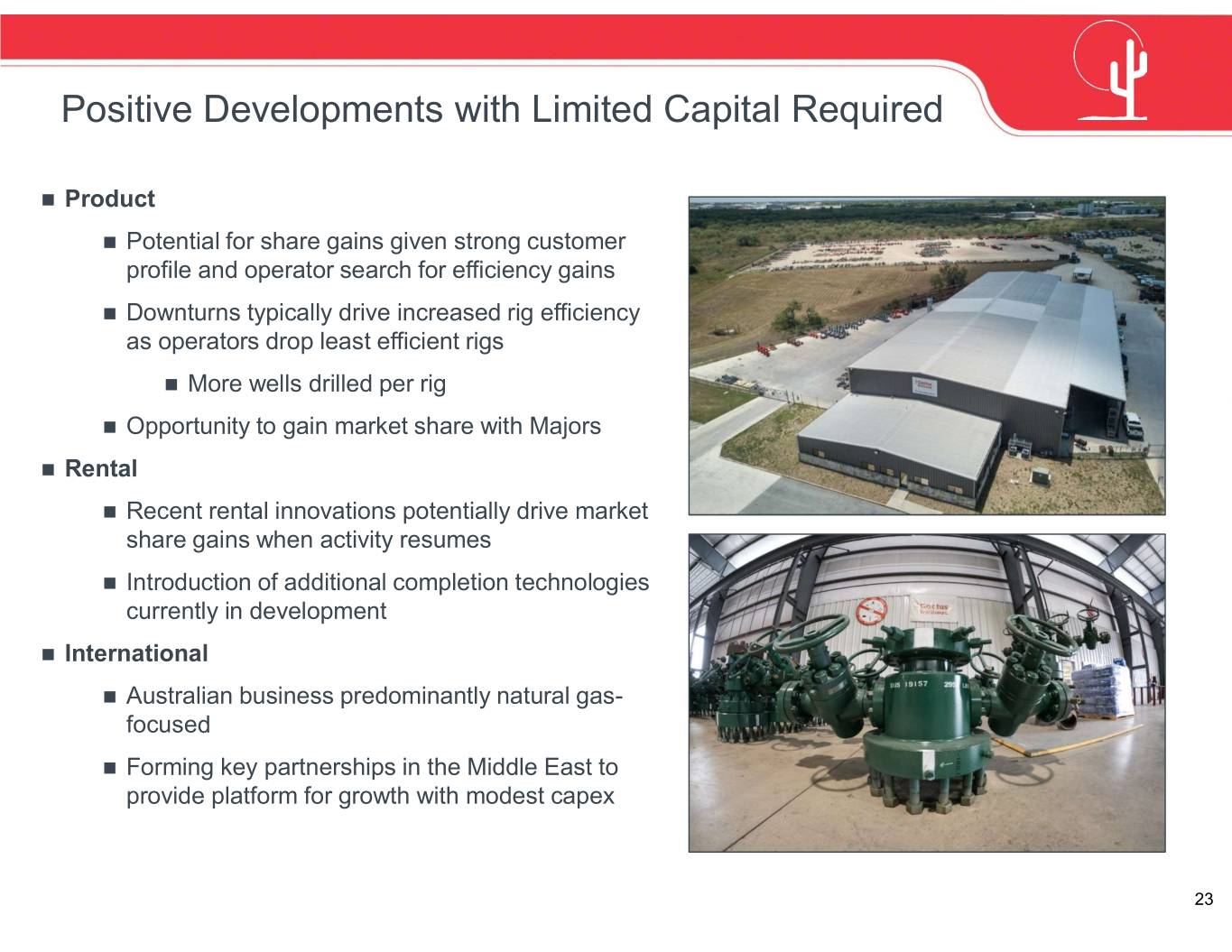
Positive Developments with Limited Capital Required Product Potential for share gains given strong customer profile and operator search for efficiency gains Downturns typically drive increased rig efficiency as operators drop least efficient rigs More wells drilled per rig Opportunity to gain market share with Majors Rental Recent rental innovations potentially drive market share gains when activity resumes Introduction of additional completion technologies currently in development International Australian business predominantly natural gas- focused Forming key partnerships in the Middle East to provide platform for growth with modest capex 23
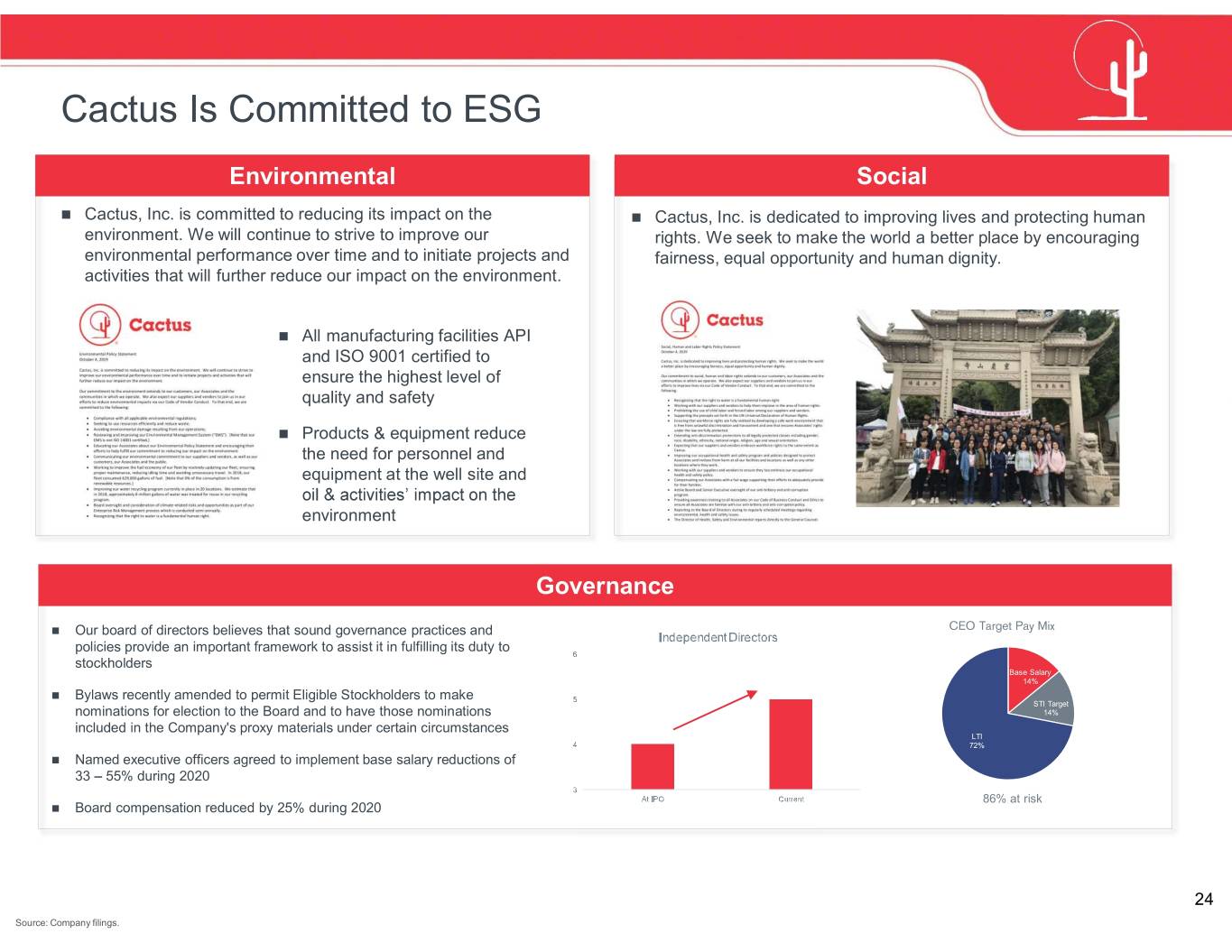
Cactus Is Committed to ESG Environmental Social Cactus, Inc. is committed to reducing its impact on the Cactus, Inc. is dedicated to improving lives and protecting human environment. We will continue to strive to improve our rights. We seek to make the world a better place by encouraging environmental performance over time and to initiate projects and fairness, equal opportunity and human dignity. activities that will further reduce our impact on the environment. All manufacturing facilities API and ISO 9001 certified to ensure the highest level of quality and safety Products & equipment reduce the need for personnel and equipment at the well site and environment Governance Our board of directors believes that sound governance practices and CEO Target Pay Mix Independent Directors policies provide an important framework to assist it in fulfilling its duty to 6 stockholders Base Salary 14% Bylaws recently amended to permit Eligible Stockholders to make 5 STI Target nominations for election to the Board and to have those nominations 14% included in the Company's proxy materials under certain circumstances LTI 4 72% Named executive officers agreed to implement base salary reductions of 33 55% during 2020 3 At IPO Current 86% at risk Board compensation reduced by 25% during 2020 24 Source: Company filings.

Appendix
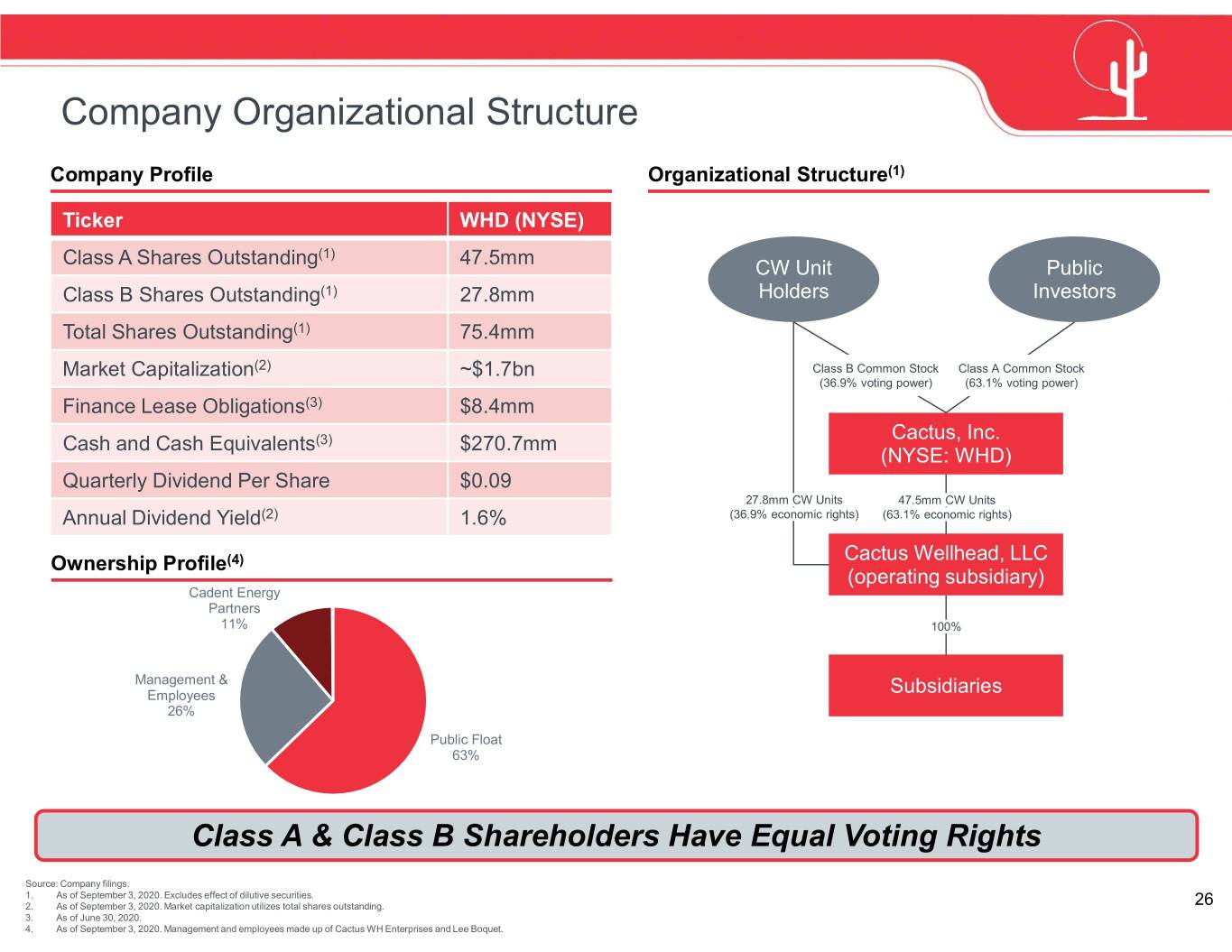
Company Organizational Structure Company Profile Organizational Structure(1) Ticker WHD (NYSE) Class A Shares Outstanding(1) 47.5mm CW Unit Public Class B Shares Outstanding(1) 27.8mm Holders Investors Total Shares Outstanding(1) 75.4mm Market Capitalization(2) ~$1.7bn Class B Common Stock Class A Common Stock (36.9% voting power) (63.1% voting power) Finance Lease Obligations(3) $8.4mm Cactus, Inc. Cash and Cash Equivalents(3) $270.7mm (NYSE: WHD) Quarterly Dividend Per Share $0.09 27.8mm CW Units 47.5mm CW Units Annual Dividend Yield(2) 1.6% (36.9% economic rights) (63.1% economic rights) Ownership Profile(4) Cactus Wellhead, LLC (operating subsidiary) Cadent Energy Partners 11% 100% Management & Employees Subsidiaries 26% Public Float 63% Class A & Class B Shareholders Have Equal Voting Rights Source: Company filings. 1. As of September 3, 2020. Excludes effect of dilutive securities. 2. As of September 3, 2020. Market capitalization utilizes total shares outstanding. 26 3. As of June 30, 2020. 4. As of September 3, 2020. Management and employees made up of Cactus WH Enterprises and Lee Boquet.
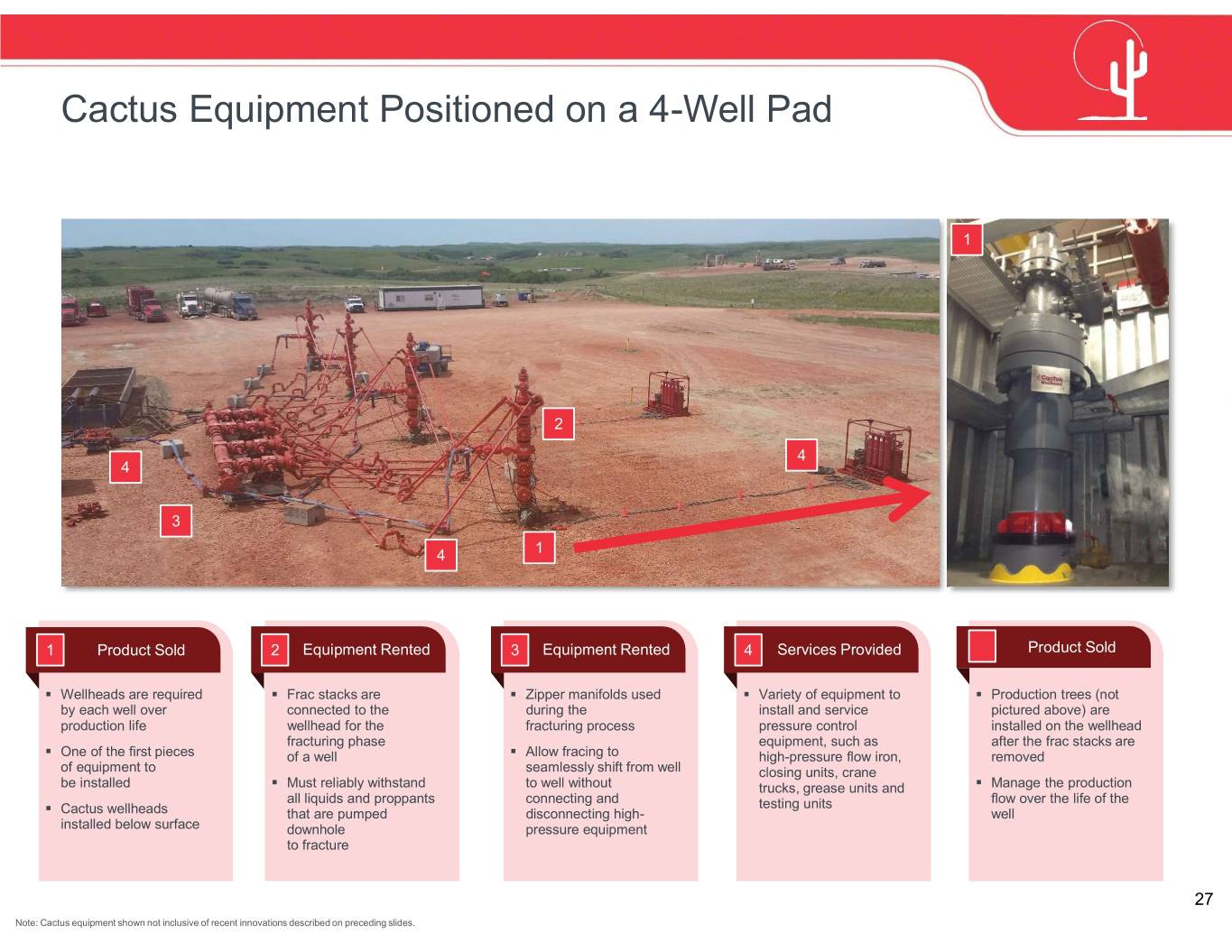
Cactus Equipment Positioned on a 4-Well Pad 1 2 4 4 3 4 1 1 Product Sold 2 Equipment Rented 3 Equipment Rented 4 Services Provided Product Sold Wellheads are required Frac stacks are Zipper manifolds used Variety of equipment to Production trees (not by each well over connected to the during the install and service pictured above) are production life wellhead for the fracturing process pressure control installed on the wellhead fracturing phase equipment, such as after the frac stacks are One of the first pieces of a well Allow fracing to high-pressure flow iron, removed of equipment to seamlessly shift from well closing units, crane be installed Must reliably withstand to well without trucks, grease units and Manage the production all liquids and proppants connecting and testing units flow over the life of the Cactus wellheads that are pumped disconnecting high- well installed below surface downhole pressure equipment to fracture 27 Note: Cactus equipment shown not inclusive of recent innovations described on preceding slides.

Non-GAAP Reconciliation Important Disclosure Regarding Non-GAAP Measures EBITDA and Adjusted EBITDA are not measures calculated in accordance with GAAP. EBITDA and Adjusted EBITDA are supplemental non-GAAP financial measures that are used by management and external users of our consolidated financial statements, such as industry analysts, investors, lenders and rating agencies. We define EBITDA as net income excluding net interest, income tax and depreciation and amortization. We define Adjusted EBITDA as EBITDA excluding severance expenses, revaluation of tax receivable agreement, (gain) loss on debt extinguishment, stock-based compensation, and equity offering expenses. We define Adjusted EBITDA Margin as Adjusted EBITDA as a percentage of Revenue. Our management believes EBITDA and Adjusted EBITDA are useful, because they allow management to more effectively evaluate our operating performance and compare the results of our operations from period to period without regard to financing methods or capital structure, or other items that impact comparability of financial results from period to period. EBITDA and Adjusted EBITDA should not be considered as alternatives to, or more meaningful than, net income or any other measure as determined in accordance with GAAP. Our computations of EBITDA and Adjusted EBITDA may not be comparable to other similarly titled measures of other companies. We present EBITDA and Adjusted EBITDA because we believe they provide useful information regarding the factors and trends affecting our business. LTM Year Ended ($ in thousands) June 30, December 31, 2020 2019 2018 2017 2016 2015 Net income (loss) $109,300 $156,303 $150,281 $66,547 ($8,176) $21,224 Interest (income) expense, net (1,396) (879) 3,595 20,767 20,233 21,837 Income tax (benefit) expense 31,010 32,020 19,520 1,549 809 784 EBIT 138,914 187,444 173,396 88,863 12,866 43,845 Depreciation and amortization 42,097 38,854 30,153 23,271 21,241 20,580 EBITDA $181,011 $226,298 $203,549 $112,134 $34,107 $64,425 Severance expenses 1,864 - - - - - Revaluation of tax receivable agreement liability (6,646) (5,336) - - - - Secondary offering related expenses - 1,042 - - - - (Gain) loss on debt extinguishment - - 4,305 - (2,251) (1,640) Stock-based compensation 7,631 6,995 4,704 - 361 359 Adjusted EBITDA $183,860 $228,999 $212,558 $112,134 $32,217 $63,144 Revenue $521,733 $628,414 $544,135 $341,191 $155,048 $221,395 Adjusted EBITDA Margin 35.2% 36.4% 39.1% 32.9% 20.8% 28.5% 28

Non-GAAP Reconciliation Important Disclosure Regarding Non-GAAP Measures EBITDA and Adjusted EBITDA are not measures calculated in accordance with GAAP. EBITDA and Adjusted EBITDA are supplemental non-GAAP financial measures that are used by management and external users of our consolidated financial statements, such as industry analysts, investors, lenders and rating agencies. We define EBITDA as net income excluding net interest, income tax and depreciation and amortization. We define Adjusted EBITDA as EBITDA excluding severance expenses, revaluation of tax receivable agreement, (gain) loss on debt extinguishment, stock-based compensation, and equity offering expenses. We define Adjusted EBITDA Margin as Adjusted EBITDA as a percentage of Revenue. Our management believes EBITDA and Adjusted EBITDA are useful, because they allow management to more effectively evaluate our operating performance and compare the results of our operations from period to period without regard to financing methods or capital structure, or other items that impact comparability of financial results from period to period. EBITDA and Adjusted EBITDA should not be considered as alternatives to, or more meaningful than, net income or any other measure as determined in accordance with GAAP. Our computations of EBITDA and Adjusted EBITDA may not be comparable to other similarly titled measures of other companies. We present EBITDA and Adjusted EBITDA because we believe they provide useful information regarding the factors and trends affecting our business. Year Ended ($ in thousands) December 31, 2017 2016 Revenues Product revenue $189,091 $77,739 Rental revenue 77,469 44,372 Field service and other revenue 74,631 32,937 Total revenues $341,191 $155,048 Costs and expenses Cost of product revenue $124,030 $62,766 Cost of rental revenue 40,519 33,990 Cost of field service and other revenue 60,602 28,470 Selling, general and administrative expenses 27,177 19,207 Total costs and expenses $252,328 $144,433 Income from operations $88,863 $10,615 Depreciation and amortization Product depreciation and amortization $3,169 $2,869 Rental depreciation and amortization 14,912 15,121 Field service and other depreciation and amortization 4,786 2,659 Selling, general and administrative expense depreciation and amortization 404 592 Total depreciation and amortization $23,271 $21,241 EBITDA Product EBITDA $68,230 $17,842 Rental EBITDA 51,862 25,503 Field Service EBITDA 18,815 7,126 Selling, general and administrative expense EBITDA (26,773) (18,615) Total EBITDA $112,134 $31,856 Stock-based compensation - 361 Total Adjusted EBITDA $112,134 $32,217 29
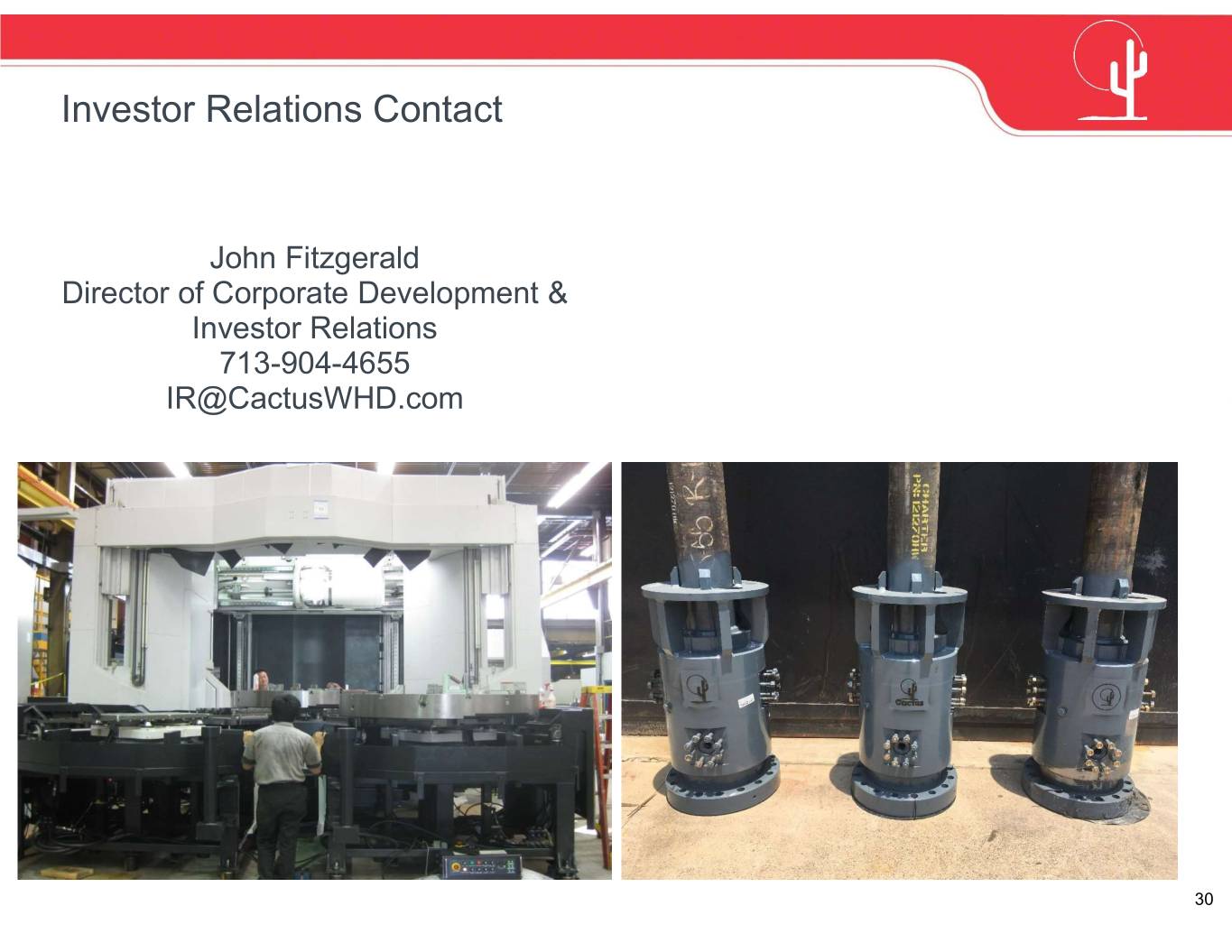
Investor Relations Contact John Fitzgerald Director of Corporate Development & Investor Relations 713-904-4655 IR@CactusWHD.com 30





























